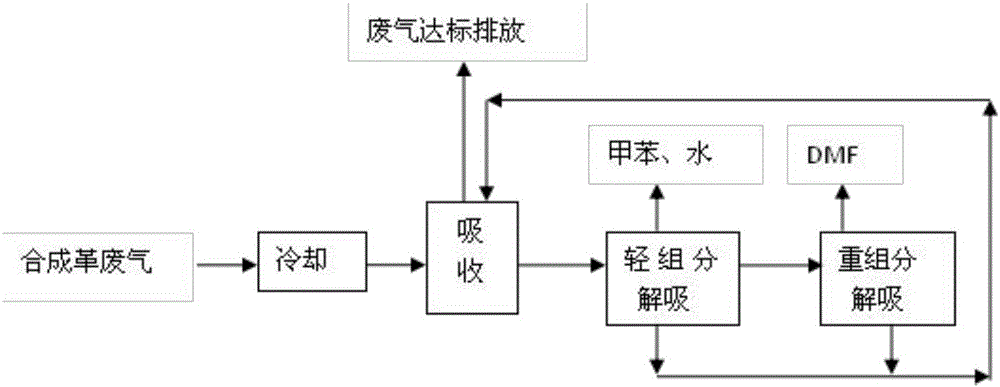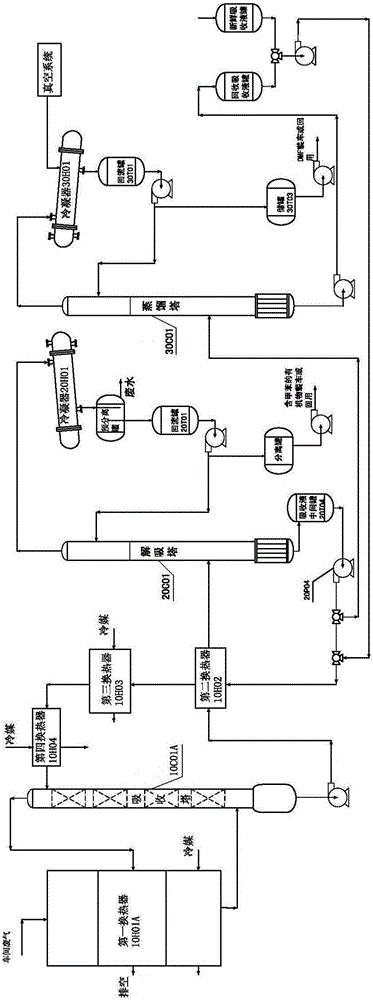Method of recycling organic substances from polyurethane synthetic leather waste gas
A technology of organic matter and synthetic leather, applied in the preparation of organic compounds, separation/purification of carbonyl compounds, organic chemistry, etc., can solve the problems of insufficient purity of DMF and toluene, low recovery efficiency, and inability to absorb, etc., to reduce secondary Pollution, high recovery efficiency, and the effect of reducing the amount of use
- Summary
- Abstract
- Description
- Claims
- Application Information
AI Technical Summary
Problems solved by technology
Method used
Image
Examples
Embodiment 1
[0036] Such as figure 1Shown, the method for recovering organic matter in a kind of polyurethane synthetic leather waste gas of the present invention, it adopts ionic liquid, liquid ester as special absorbent (this special absorbent boiling point is higher than 300 ℃, volatility is very little, does not need to be absorbed in the absorption tower) It will be carried to the top of the tower, and the exhaust gas at the top of the absorption tower can be directly discharged, so the absorbent can be separated from toluene, methyl ethyl ketone, DMF and other organic substances through one absorption), in the absorption tower, through low-temperature spraying The method absorbs and treats the cooled synthetic leather waste gas that flows upstream. After the organic substances such as toluene, butanone and DMF in the waste gas are absorbed by the low-temperature absorbent, they enter the desorption tower for desorption, separation and recovery of toluene, butanone and low-boiling orga...
Embodiment 2
[0051] A method for recovering organic matter in waste gas of polyurethane synthetic leather according to the present invention, the specific process is the same as that of Example 1, the difference is that: absorption process conditions: the operating temperature of the absorption tower is 5°C, and the tower pressure is 100KPa absolute pressure; light component desorption Process conditions: desorption tower temperature 150°C, tower pressure 100KPa absolute pressure; reorganization desorption process conditions: vacuum distillation tower temperature 130°C, tower pressure 30KPa absolute pressure;
[0052] The reflux ratio in above-mentioned steps (2) and step (3) is 5;
[0053] The mass percentage of each component in the special absorbent is: 55% of ionic liquid, 5% of dibutyl terephthalate, 25% of butylene terephthalate, and 15% of ethylene isophthalate; among them, The ratio between ionic liquid and dibutyl terephthalate is 11:1; the ratio between butylene terephthalate and...
Embodiment 3
[0055] A method for recovering organic matter in waste gas of polyurethane synthetic leather according to the present invention, the specific process is the same as in Example 1, the difference is that: absorption process conditions: the operating temperature of the absorption tower is 8°C, and the tower pressure is 150KPa absolute pressure; light component desorption Process conditions: desorption tower temperature 180°C, tower pressure 150KPa absolute pressure; recombination desorption process conditions: vacuum distillation tower temperature 150°C, tower pressure 70KPa absolute pressure;
[0056] The reflux ratio in above-mentioned steps (2) and step (3) is 0.5;
[0057] The mass percentage of each component in the special absorbent is: 60% of ionic liquid, 20% of dibutyl terephthalate, 15% of butylene terephthalate, and 5% of ethylene isophthalate; among them, The ratio between ionic liquid and dibutyl terephthalate is 3:1; the ratio between butylene terephthalate and ethy...
PUM
| Property | Measurement | Unit |
|---|---|---|
| Boiling point | aaaaa | aaaaa |
Abstract
Description
Claims
Application Information
 Login to View More
Login to View More - R&D
- Intellectual Property
- Life Sciences
- Materials
- Tech Scout
- Unparalleled Data Quality
- Higher Quality Content
- 60% Fewer Hallucinations
Browse by: Latest US Patents, China's latest patents, Technical Efficacy Thesaurus, Application Domain, Technology Topic, Popular Technical Reports.
© 2025 PatSnap. All rights reserved.Legal|Privacy policy|Modern Slavery Act Transparency Statement|Sitemap|About US| Contact US: help@patsnap.com


